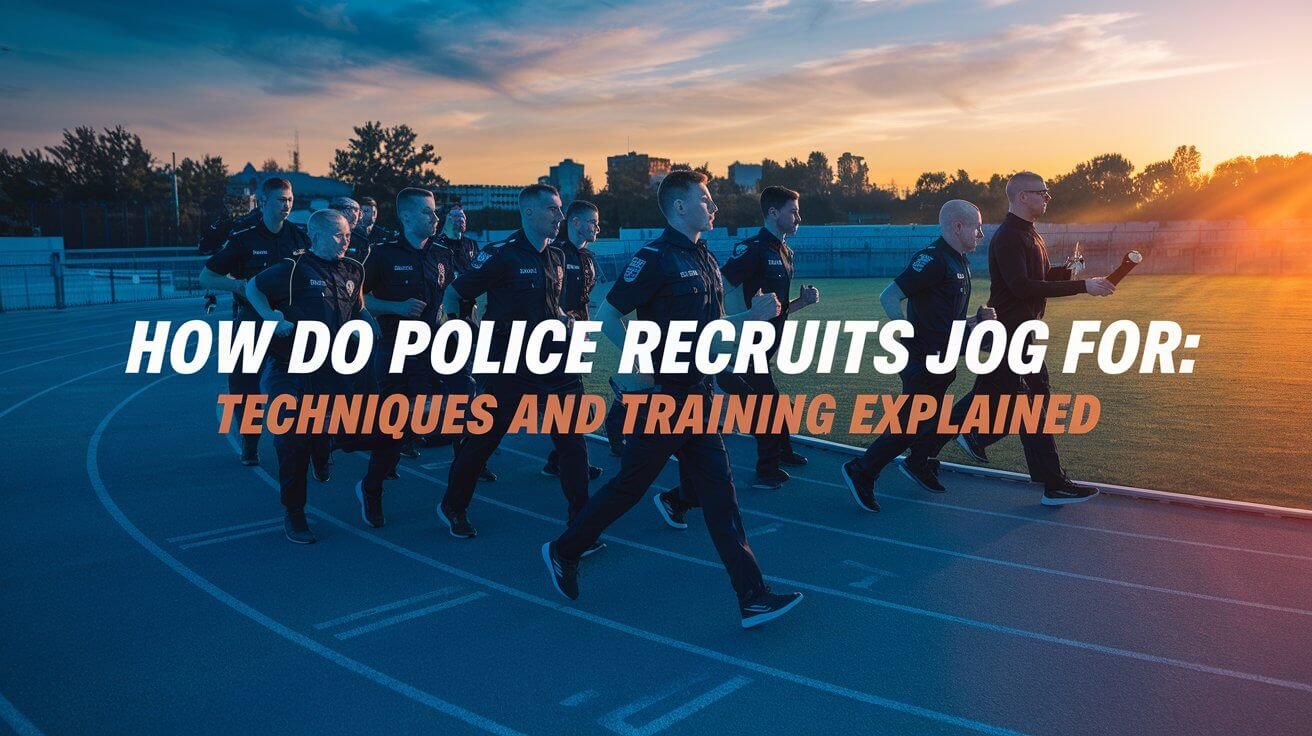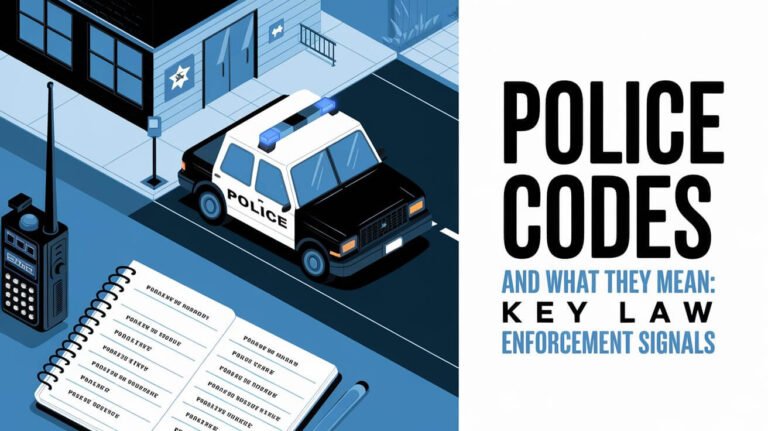How Do Police Recruits Jog For: Techniques and Training Explained

Police recruits face tough physical tests to become officers. They must run 1.5 miles in under 14 minutes and 40 seconds. But how do they get ready for this tough challenge? Let’s explore their training.
Physical Fitness Standards for Police Academy Candidates
Aspiring police officers need to show top-notch physical fitness. This is because police work is very demanding. In the United States, police academies have strict fitness tests. These tests check how well candidates can run both long distances and short sprints.
Time Requirements for Running Tests
Candidates must run 1.5 miles in under 14 minutes and 40 seconds. This shows their heart health. They also have to sprint 300 meters in under 65 seconds. This shows their quickness and strength.
Distance Requirements for Jogging
Police academy hopefuls also have to meet certain jogging distances. For example, the California Highway Patrol (CHP) requires a 300-meter dash in under 70 seconds. They also need to run 1.5 miles in 13 minutes and 35 seconds or less.
Baseline Fitness Expectations
Aspiring police officers must also show they are strong. They are tested on how many push-ups and sit-ups they can do in one minute. This shows their muscle strength and core stability.
| Fitness Test | Minimum Requirement | Ideal Standard |
|---|---|---|
| 1.5-Mile Run | Under 14:40 | Men: Under 12:30 Women: Under 14:00 |
| 300-Meter Sprint | Under 65 seconds | Under 60 seconds |
| Push-Ups (1 minute) | 34 | Men: 40+ Women: 20+ |
| Sit-Ups (1 minute) | 38 | 50+ |
These fitness standards make sure police academy candidates are ready. They need endurance, strength, and agility for law enforcement.
Basic Endurance Running Program for Aspiring Officers
Police officer candidates need to build a strong aerobic base. This is key for the physical demands of the academy. A basic endurance running program helps them achieve this.
The program should increase weekly mileage slowly. It should include long slow distance runs and aim to reduce 1.5-mile test times. Men should aim for under 9:44 minutes, and women for under 12:30 minutes to stand out.
- Begin with a walk/run routine, alternating 5 minutes of walking and 5 minutes of running. Aim for a 30-minute self-paced run.
- Slowly increase weekly mileage by no more than 10% to avoid injuries.
- Do one long slow distance run each week, increasing the time gradually.
- Include speed work, like interval training, to boost 1.5-mile test times.
- Make sure to have enough rest between runs to avoid burnout and injury.
Sticking to a police officer cardio workout and recruit jogging regimen, aspiring officers can master endurance running. This prepares them for the physical tests and the challenges of the police academy.
How Do Police Recruits Jog For Academy Preparation
Aspiring law enforcement officers face tough physical fitness tests in police academy. To get ready, they need to build a strong running base. This means jogging regularly.
Building Base Mileage
Having a good aerobic base is key for police academy. Recruits start with 10-15 miles a week. They aim for 25-30 miles over months. This boosts their police recruit stamina and law enforcement conditioning.
Speed Work Training Methods
- Interval training: Recruits do interval sessions. They run fast, then jog or walk to recover. This builds police academy training for speed and power.
- Fartlek runs: These are speed play workouts. They run fast, then jog easy. It prepares them for law enforcement conditioning demands.
Recovery Techniques Between Runs
Recruits must recover well between runs to avoid injuries. They should:
- Get enough rest and sleep
- Use foam rolling and self-myofascial release
- Stay hydrated and eat right, including protein and carbs after running
Mixing base mileage, speed work, and recovery, recruits build the stamina needed for academy training and more.
Training Schedule for 1.5-Mile Police Fitness Test
Police officers need to be in top shape for their job. The 1.5-mile run is a key test of their fitness. It checks their heart health and leg strength. To get ready, recruits need a detailed training plan that includes different types of runs.
The plan should mix distance runs, interval training, and tempo runs. Recruits should run 3-4 times a week. They should slowly increase how far and fast they run. This helps them get better and pass the test.
- Distance Runs: These runs build a strong heart and lungs. Start with 20-30 minutes and go up to 45-60 minutes.
- Interval Training: This involves running fast and then resting. Start with 400-meter runs and aim for 800-meter or 1-mile runs later.
- Tempo Runs: These runs help you run more efficiently. Try to run a bit faster than your goal pace.
Recruits also need rest days and other exercises like cycling or swimming. This helps avoid injuries and boosts fitness. Stretching and recovery, like foam rolling and ice baths, are also key.
| Week | Distance Runs (minutes) | Interval Training | Tempo Runs (minutes) |
|---|---|---|---|
| 1 | 20-30 | 4 x 400m | 20 |
| 2 | 25-35 | 4 x 400m | 25 |
| 3 | 30-40 | 4 x 800m | 30 |
| 4 | 35-45 | 4 x 800m | 35 |
| 5 | 40-50 | 4 x 1 mile | 40 |
Sticking to this plan, recruits can boost their endurance and speed. This increases their chances of passing the 1.5-mile test.
Sprint Training Requirements for Law Enforcement
Law enforcement officers must prepare for the police academy’s challenges. Sprint training is key to improve their anaerobic skills and explosive power. This is vital for the 300-meter run test, a key part of police fitness tests.
300-Meter Run Preparation
The 300-meter run is a tough test that requires quick speed and endurance. To do well, recruits must work on their anaerobic capacity. They can do this with sprint workouts like:
- Repeated 100-meter sprints with short breaks
- Hill sprints to boost leg strength
- Ladder drills that mix sprinting and jogging
Interval Training Protocols
Police academy candidates also need to master various interval training protocols. These exercises mimic the quick actions needed in law enforcement. Some effective interval training for police academy training, law enforcement conditioning, and physical fitness requirements include:
- AMRAP (As Many Reps As Possible) workouts with Assault Bike, Push-ups, and Air Squats
- EMOM (Every Minute On the Minute) series with Bike Erg, Suitcase Carry, and Dumbbell Squat to Press
- Rounds for Time (RFT) challenges with Row Erg, Rope Rack Climb, Ski Erg, and Sandbag Carry
- Tabata intervals of 20-second work and 10-second rest periods across 4 exercises
- Timed circuits with 30-second work and 30-second rest periods for 5 rounds
- Complexes like the Kettlebell Complex, which combines multiple exercises
Learning these sprint and interval training methods, police recruits can build the explosive power and anaerobic capacity needed. This will help them succeed in the police academy and their future careers.
Combining Strength Training with Running Routines
Effective police training mixes strength exercises with running. This mix boosts the fitness needed for police work. It combines stamina building, law enforcement conditioning, and cardio workout.
A recent study found law enforcement recruits improved a lot in fitness. They got better in vertical jump and strength. But, fitness gains slowed down later, possibly because of muscle changes.
To keep fitness improving, police academies use different training methods. These include:
- Bodyweight exercises like pushups and situps between running intervals
- Circuit training that alternates cardio and strength stations
- Resistance training on non-running days
Strength and power training help police officers face any situation. Cardio training lets them work under stress. A balanced program with mobility, strength, and endurance training boosts their performance and fitness.

Nutrition Guidelines for Police Recruit Runners
Good nutrition is key for police recruit runners. It helps them prepare for the academy’s challenges. Eating the right foods boosts their training and performance, improving their success chances.
Pre-Run Fuel Recommendations
Before running, focus on carbs and lean proteins. This mix gives lasting energy and aids muscle recovery. Here are some good pre-run foods:
- Whole grain toast with peanut butter
- Oatmeal with berries and Greek yogurt
- Banana with a handful of almonds
Post-Run Recovery Meals
After running, it’s vital to refill glycogen and repair muscles. Ideal meals should mix carbs, proteins, and fats. Here are some great options:
- Grilled chicken with sweet potato and steamed vegetables
- Salmon, brown rice, and roasted broccoli
- Quinoa bowl with black beans, avocado, and sautéed spinach
Drinking enough water is also key for runners. It keeps the body cool, prevents dehydration, and boosts performance.
| Nutrient | Importance for Police Recruit Runners |
|---|---|
| Carbohydrates | Provide the primary fuel source for endurance exercise |
| Protein | Supports muscle recovery and repair after strenuous training |
| Healthy Fats | Contribute to energy production and hormone regulation |
| Hydration | Regulates body temperature and supports overall physical performance |
Sticking to these nutrition tips, police recruit runners can fuel their bodies right. This optimizes their training and boosts their success in the police academy.
Common Running Injuries Prevention for Recruits
Aspiring police officers face a tough challenge in endurance running during academy training. Injury prevention is key, as studies show a high injury rate of 368.63 injuries per 1,000 recruits per year. Female recruits often have higher injury rates than males, even at different fitness levels.
To lower these risks, recruits need to focus on proper warm-up and cool-down routines. They should also gradually increase their training intensity and wear the right shoes. Keeping the right running form and fixing muscle imbalances through strength training can help prevent injuries. These steps can reduce the risk of injuries to joints and ligaments, which make up nearly half of all injuries.
Knee injuries are the most common, making up 23.17% of all incidents. Recruits should pay extra attention to their knees. They should do exercises that strengthen the muscles around the knee and stabilize the joint. Also, building a strong aerobic base through gradual increases in mileage can boost endurance and resilience.
Focusing on injury prevention, police recruits can better their chances of finishing the academy. This also sets a strong foundation for a long, healthy career in law enforcement. Investing in proper physical preparation can greatly benefit both the individual and the department’s overall effectiveness.
Weather Adaptation Strategies for Outdoor Training
Police recruits must get used to different weather during their outdoor training. In places like Alaska, temperatures can drop to 10 degrees below zero or rise to 35 degrees above in just 10 hours. To stay comfortable, recruits should wear layers, starting with “longjohns” and adding insulating jackets.
It’s important to avoid cold injuries like frostbite and hypothermia. Recruits should have extra clothes for when they get wet and use hand and foot warmers to stay warm. They also need gear like snowmobiles and ice cleats to move safely on ice, but they must be careful not to slip.
Recruits also need to learn how to keep their gear working in the cold. This includes using hand warmers near radio batteries and applying silicone to holsters to prevent freezing. Keeping a warm vehicle is key, with tricks like using snap-on grille covers to keep the engine warm. By adjusting their training and gear for the local weather, recruits can be ready for any weather condition.
Most asked questions
What are the physical fitness standards for police academy candidates?
Police academy applicants need to pass certain tests. They must run 1.5 miles in under 14:40. They also need to do 34 pushups and 38 sit-ups in one minute. Lastly, they must run 300 meters in under 65 seconds.
How long is the basic law enforcement training?
Basic law enforcement training lasts about 840 hours or 21 weeks. Recruits spend around 49 hours on health and fitness training.
What are the running requirements for police academy training?
Police academies require a 1.5-mile run in under 14:40 and a 300-meter run in under 65 seconds. These tests check their cardiovascular endurance and sprinting ability.
What are the baseline fitness expectations for police recruits?
Police recruits must be able to do 34 pushups and 38 sit-ups in one minute. This shows they are physically ready for law enforcement duties.
How should aspiring officers prepare for the police academy running requirements?
Aspiring officers should build a strong aerobic base through running. They should do long slow distance runs and work on reducing their 1.5-mile test times.
What training methods should police recruits use to prepare for academy requirements?
Police recruits should jog consistently to build base mileage. They should also do interval training and fartlek runs. It’s important to practice recovery techniques too.
What should a training schedule for the 1.5-mile police fitness test include?
A training schedule should mix distance runs, interval training, and tempo runs. Recruits should aim to run 3-4 times a week. They should gradually increase distance and intensity.
How should police recruits prepare for the 300-meter run test?
Sprint training for law enforcement includes interval training. This includes repeated 100-meter sprints, hill sprints, and ladder drills. It prepares them for the 300-meter run test.
How can police recruits combine strength training with running routines?
Police training combines strength exercises with running. This includes doing pushups and situps between running intervals. Circuit training that alternates cardio and strength stations is also effective. On non-running days, recruits should do resistance training.
What are the nutrition guidelines for police recruit runners?
Proper nutrition is key for police recruit runners. They should eat easily digestible carbs and lean proteins before running. After running, they should focus on replenishing glycogen stores and providing protein for muscle repair.
How can police recruits prevent running injuries?
To prevent running injuries, recruits should warm up and cool down properly. They should gradually increase their training intensity. Wearing the right footwear and addressing muscle imbalances through strength training are also important.
How should police recruits adapt to various weather conditions for outdoor training?
Police recruits need to adapt to different weather conditions. In cold weather, they should layer their clothing. In hot weather, they should stay hydrated and wear light-colored, moisture-wicking clothing. They should also adjust their run timing to avoid extreme temperatures.






